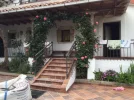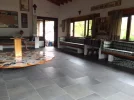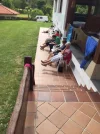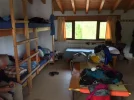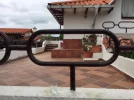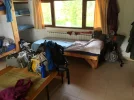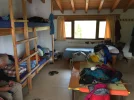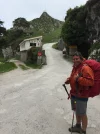Lucy,
I walked the del Norte from Irun to Santiago April 28 to June 3, this year. It was my first camino. As you said, there is a lot of info on the caminos out there. This forum is very good as a reference point for asking questions and getting advice. The only issue is the information here comes from a very big group of pilgrims with a very big difference in experience, and that sometimes can be overwhelming as well. In a previous post on this forum, I listed some of the lessons I learned from my own camino. I will list some of them for you.
1). Before I left for Spain, I went to my local AT&T cellphone office and had them connect my cell phone to the Spanish phone system (voice, data, text $30 per month). I had internet, voice and text whenever my phone was on. I did this primarily because I planned to walk alone as much as possible.
2). I used the stages of the del Norte from the gronze.com website to establish my itinery for overnights/rest days and day/dates on the camino. The gronze.com website lists albergues, hotels and pensions available at almost all the towns, cities and villages, but for some reason does not list all of them. I'm guessing it' s a pay for posting issue. If my plans changed, I could make adjustments to my hotel/albergue/pension while on the camino at rest stops. Almost every bar, restaurant and pension had WiFi (pronounced Whiffee in Spain). All you have to do is ask if they have WiFi, and then ask for the access code. Most were posted somewhere in the facility. Also, the gronze.com stages show the distances between towns and also at the bottom of the stage page, there is a vertical profile indicating the ups and downs.
3). The del Norte is very challenging during the first 8 stages due to the steep ups and downs, especially the downs! By the time I arrived in Guernika, end of Stage 5, there were injured pilgrims everywhere, a lot of them coming and going to/from the La Farmacias. Tendonitis, blisters, feet and knee issues, etc. I was no exception. I suffered from blisters, blood blisters and muscle issues (campartment syndrome with shin muscles). My initial damage, blisters, was incurred on Stage 1, Irun - San Sebastian. Everybody I met or walked with had Compeed, Vaseline and Ibuprofen tablets. I will add that I trained for six months before I left. During the last two months of training, I had a full backpack, had broke in two pairs of footwear, and hiked 9.5 miles (15 km) every morning. In Guernika one night (end of Stage 5) I was in a pension with about 6 other pilgrims eating dinner in the common area and asked them all if they thought that there was any way to prepare for the del Norte. Without exception, we all agreed that the answer was NO! Some were first timers, others had lots of hiking experience, some had had walked other caminos. We all had the "camino limp".
4). This is the most important item. Buy a good set of adjustable trekking poles and learn how to use them correctly (length and straps)! I had a set with me but did not know how to use them properly and was stumbling along like a newborn pony. They got stowed in my backpack. During Stage 14 I walked with a very experienced trekking guide who showed me the correct way to use my "sticks". From that point on it was a totally different camino. My wounds healed fully in three days. I could move at twice the speed with about half the effort. Hills, mud bogs and slippery trails were no problem. In the Miraz albergue I met a pilgrim from Germany who had 3-4 big blisters on both feet. Hed had white sewing thread and Compeed covering the bottom of both feet. He said he was on his way home because he couldn't take the pain anymore. I asked him if he had sticks. He said no. I suggested he get some and showed him how I used mine. I saw him next in Sobrado outside the monastary, walking with sticks. He said he was much better and thanked me for showing him how to use them. As he left, I noticed he was not using the straps correctly and mentioned it to him. He asked how to use them. I showed him how to put his hands through the loops from the bottom and then grip the handles. Well off he went, using the sticks correctly. The next time I saw him was in Pilgrim City in Santiago, a great big smile all over his face. He'd finished his camino. He couldn't thank me enough. It was one pilgrim helping another pilgrim, just as I'd been shown.
5). I had packed my backpack for any contingency such as rain and cold; tent, tarp, inflatable sleeping bag cushion, rain jacket/pants, etc. After a week and no rain I sent tent, tarp and cushion home. A week later the cold weather clothes went home. I lightened my pack by about 6-7 lbs. my experience at that point told me I was going to get a bed every night (not a lot of pilgrims on the Norte in Aptil/May). I am planning my next camino, Portuguese, and will do things a little different, but go same time of year as I don't do hot very well. No tent gear, lighter clothes but more of them for weight (layering) and take my lightweight Marmot rain jacket and pants. I bought the
Brierly guide for the Portuguese but will still use gronze.com to check on current data.
I hope this helps a little. There is more, but that is mostly preference items. I haven't seen the
Brierly Guide for the del Norte, but if it is like the Portuguese, I would buy it.
The camino del Norte is waymarked fairly well, but in some provinces the direction indication changes 180 degrees so I would research that. After Ribadeo, it is almost impossible to get lost and the direction indication is as it should be, at least in my humble opinion.
I stayed at a few hotels/pensions along the way and would recommend them if you would like. One in particular that I liked and went back to after my camino (and spent three days there while I explored that city) was the Hotel Santa Cruz. The owner/manager's name is Henri. He is a very hard working, guest oriented knowledgeable young man. He has walked the del Norte and made several recommendations to me that worked out very well. The hotel has a restaurant/bar and is on the camino. You can see the bronze scallop shells in the sidewalk just outside the door.
I also got into the habit of visiting the Tourist Information Office first thing after checking into the albergue/hotel/pension at every layover. I needed to find out where the camino was and where it went as I left town. In some places (La Caridad), the scallop shells, signs and trail markers just disapear. During daylight, I would use the info from the tourist office to find the camino and follow it for a bit the night before leaving town. This camino is not like the Frances until Arzua. There are times when you are alone and don't have large groups of pilgrims to follow
And lastly, I would download the ALSA bus app and probably the one for booking.com as well.
Buen camino.
WV











